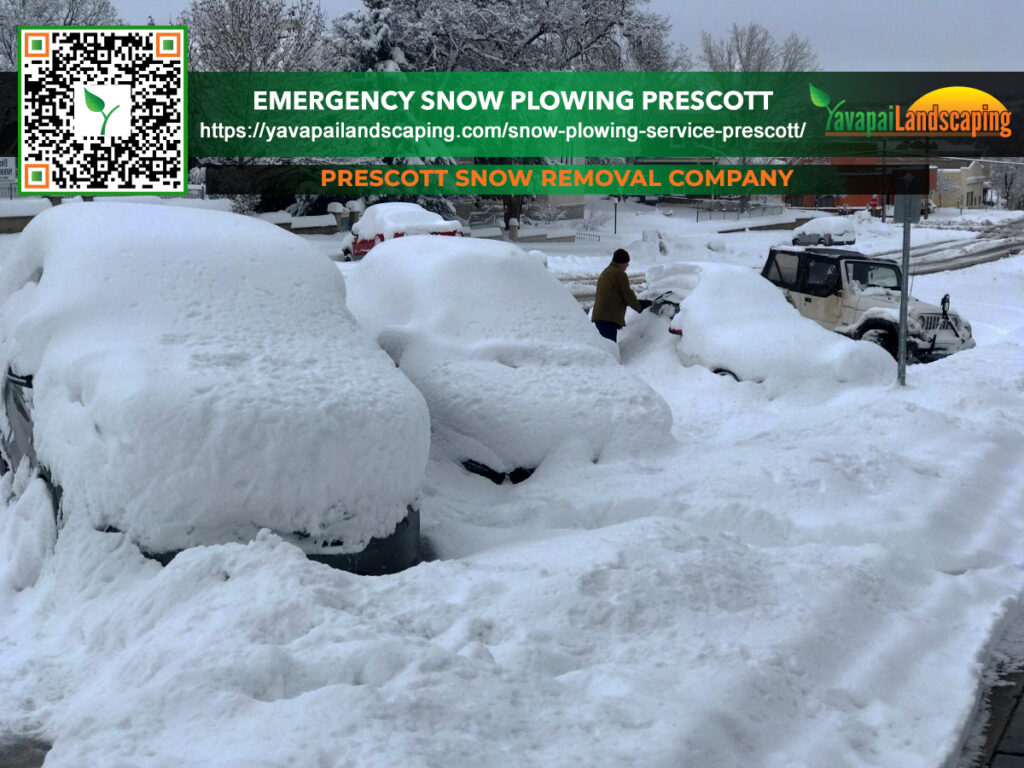
Winter months in Prescott, AZ, particularly during emergency snowfall situations, can be challenging for snow plow operators. With unpredictable weather conditions, including sudden heavy snowfall, it is essential to have effective strategies in place for Emergency Snow Plowing. In Prescott, where snow events can be unexpected, managing your snow plow fleet becomes crucial. In this article, we will explore how GPS tracking systems, especially in the context of Prescott, can help you manage your snow plow fleet efficiently and cost-effectively during emergencies and routine winter maintenance.
Key Takeaways
- GPS tracking systems can optimize snow plow fleet operations in Prescott, AZ.
- Efficient route planning and real-time location updates help enhance fleet operations.
- GPS tracking technology can reduce fuel consumption and vehicle maintenance costs.
- Driver safety and productivity can increase with GPS tracking systems in place.
- Implementing GPS tracking systems can lead to overall cost savings in snow plow fleet management.
Efficient Route Planning for Snow Plow Fleets
Efficient route planning is a crucial aspect of snow plow fleet management. With GPS tracking systems, fleet managers can optimize the routes for snow plow vehicles, minimizing travel time and reducing fuel consumption. GPS tracking software allows you to use real-time location updates and advanced mapping features to provide accurate data for efficient route planning.
By collecting data on traffic, road conditions, and other factors affecting the journey, fleet managers can develop custom route maps for drivers. The use of GPS also allows managers to track vehicles in real-time as they follow their respective routes, making it easy to adjust routes or change plans according to the situation on the ground.
For instance, when there are weather-related road closures, real-time insights allow managers to adjust routes promptly.
Route optimization case study
Johnson Contractors, a snow plow fleet management company in Prescott, Arizona, implemented GPS tracking systems to optimize route planning and provide fleet optimization services to their clients. By analyzing data, the company was able to boost productivity, reduce fuel consumption, and reduce vehicle wear and tear.
| Key Metrics | Before GPS Tracking Implementation | After GPS Tracking Implementation | Difference |
|---|---|---|---|
| Travel Time | 3 hours 45 minutes | 2 hours 30 minutes | 1 hour 15 minutes (33.33%) |
| Fuel Consumption | 15 gallons | 11 gallons | 4 gallons (26.67%) |
| Driver Wages | $100 | $100 | No difference |
| Vehicle Wear and Tear | High | Low | Significant improvement |
The data in the table indicates that the implementation of GPS tracking and efficient route planning led to significant improvements in travel time, fuel consumption, and vehicle wear and tear for Johnson Contractors.
Overall, GPS tracking systems contribute to efficient routing and planning, resulting in cost savings and improved productivity.

Real-time Location Updates for Enhanced Fleet Operations
In Snow Plow fleet management, real-time location updates provided by GPS tracking systems play a crucial role. With accurate and up-to-date data, fleet managers can monitor the progress of each vehicle and identify potential issues. Real-time location updates help in making necessary adjustments on the go, leading to efficient and optimal fleet operations.
By leveraging real-time location updates, fleet managers can monitor current weather conditions, traffic congestion, and road closures affecting the fleet’s operations and route planning. This information guides decision-making and helps fleet managers modify their route planning to ensure on-time delivery of services.
Real-time Location Updates for Fleet Management Efficiency
Real-time location updates through GPS tracking systems provide real-time information on the location of your fleet, including each vehicle’s location, direction, and speed. This data is crucial in enhancing fleet operations, making it easier for managers to observe, evaluate, and optimize the fleet’s movement and utilization. With real-time location updates, fleet managers can identify the most efficient routes, reducing unnecessary idling, and improving overall fuel efficiency for their vehicles.
Furthermore, fleet managers can use real-time location updates to make informed decisions about task allocation for their snow plow operators. They can identify which vehicle is closest to a specific job site and assign tasks accordingly, avoiding unnecessary travel distances. Real-time location updates make fleet management more agile and efficient, leading to reduced costs and an optimized workload.
The Role of GPS Tracking Systems in Real-time Location Updates
GPS tracking systems serve as the backbone for real-time location updates in snow plow fleet management. These systems utilize a combination of GPS, cellular, and satellite technology to track snow plow vehicles’ exact locations. Fleet managers can access this location data through a user-friendly dashboard to track each route’s progress in real time.
Through real-time location updates, fleets can communicate with their operators to make necessary adjustments to optimize travel routes and reduce travel time. This communication network allows for a more efficient and productive operation. With data-driven insights, fleet managers can make quick and strategic decisions on the ground, reducing response times, and ensuring smooth and swift operations for their snow plow fleets.
Fuel Consumption Optimization for Cost-effective Snow Plow Management
One of the biggest costs in snow plow fleet management is fuel consumption. However, GPS tracking systems can help reduce fuel costs by optimizing fuel usage. By analyzing data such as speed, idling time, and mileage, fleet managers can identify fuel inefficiencies and implement strategies to minimize fuel consumption without compromising service quality.
Implementing fuel-saving measures can lead to significant cost savings. For example, reducing idling time by one hour per day for each snow plow vehicle can result in an average annual fuel cost savings of $225 per vehicle. Optimizing routes and reducing unnecessary travel time can further reduce fuel consumption and increase operational efficiency.
How GPS Tracking Systems Help Optimize Fuel Consumption in Snow Plow Fleets
GPS tracking systems provide real-time data on vehicle location and performance, allowing fleet managers to closely monitor fuel usage. By identifying areas for improvement, fleet managers can develop strategies to optimize fuel consumption, such as:
- Reducing idling time: Fleet managers can use GPS tracking to monitor idling time and identify areas where it can be reduced.
- Optimizing routes: By using GPS tracking to create optimized routes, fleet managers can minimize travel time and reduce fuel consumption.
- Managing vehicle speed: GPS tracking systems can monitor vehicle speed and provide alerts when drivers exceed speed limits, allowing fleet managers to reduce fuel consumption and promote safe driving practices.
- Avoiding traffic: GPS tracking systems can help identify areas with heavy traffic, enabling drivers to avoid congested routes and reduce idle time and fuel consumption.
The Cost Savings of Fuel Consumption Optimization for Snow Plow Fleet Management
In addition to the cost savings from reducing idling time, optimizing routes, and managing vehicle speed, fuel consumption optimization can also lead to savings through reduced wear and tear on vehicles over time. By implementing strategies to reduce fuel consumption, snow plow fleet managers can reduce overall vehicle maintenance costs, prolonging the lifespan of their vehicles and avoiding unnecessary repair costs.
Vehicle Maintenance Tracking for Improved Longevity
Proper maintenance is crucial to keep your snow plow fleets running efficiently and minimize downtime. Without regular car maintenance, small issues can turn into costly repairs and even lead to catastrophic failures. That’s where vehicle maintenance tracking comes in as a crucial component of snow plow fleet management.
GPS tracking systems enable fleet managers to keep track of scheduled maintenance tasks such as oil changes, tire rotations, and brake inspections. By tracking these tasks, managers can receive real-time alerts whenever a maintenance task is due, ensuring timely maintenance that helps prolong the longevity of snow plow vehicles.
By regularly performing maintenance tasks, snow plow fleets can minimize breakdowns and extend the lifespan of their vehicles. This proactive approach also helps ensure the safety of snow plow operators and other road users.
Moreover, with maintenance data and records at hand, fleet managers can diagnose potential issues early, schedule repairs before they turn into major problems, and maintain a detailed history of vehicle maintenance that can inform future purchasing decisions. Get to know more about How Emergency Snow Removal Contribute to Safer Winter Roads in Prescott.

Enhanced Driver Safety for Snow Plow Operators
If you are a fleet manager of snow plow vehicles, then you understand how critical driver safety is for your business. With GPS tracking systems, you can now contribute to enhanced driver safety and create a work environment where your operators can perform their duties efficiently and safely.
The enhanced driver safety feature of GPS tracking systems allows managers to monitor the speed, braking patterns, and other behaviors of snow plow operators. This ensures that drivers are following safe practices and are aware of their driving habits. Real-time road condition updates also assist drivers in avoiding hazardous conditions, reducing the risk of accidents.
The snow plowing industry is often associated with dangerous work conditions, but GPS tracking systems can help minimize potential hazards and create a safer working environment for your team members.
Increased Productivity for Snow Plow Operations
Implementing GPS tracking systems for snow plow fleet management can greatly increase productivity. Through efficient task allocation, accurate data, and streamlined communication, fleet managers can enhance coordination among team members, minimize downtime, and maximize the efficiency of snow plow operations.
For instance, with real-time location updates provided by GPS tracking systems, fleet managers can monitor the progress of each vehicle, identify potential roadblocks, and adjust routes accordingly. Using advanced mapping features, fleet managers can optimize snow plow vehicle routes, reducing travel time, fuel consumption, and costs.
Task Allocation Efficiency with GPS Tracking Systems
The allocation of tasks can greatly impact the productivity of snow plow operations. Using GPS tracking systems, fleet managers have access to accurate and real-time data that enables efficient allocation of tasks based on snow plow vehicle location and capacity. This results in more streamlined task assignments and minimized transit inefficiencies. Ultimately, less idle time and more efficient task allocation result in increased productivity and a more effective fleet operation.
Effective Communication with Drivers
GPS tracking systems enable more effective communication between snow plow drivers and fleet managers. Fleet managers can provide accurate location information to drivers and update them on any changes regarding their assigned tasks. Additionally, drivers have access to real-time road and weather conditions, so they can make quick and informed decisions. All of these factors together improve communication efficiency, increasing overall productivity for the snow plow operation.
Cost-effective Snow Plow Management with GPS Tracking
Are you looking for a cost-effective solution for managing your snow plow fleet? Look no further than GPS tracking technology. By implementing a GPS tracking system in your snow plow fleet management, you can save money in several ways.
Firstly, GPS tracking systems help optimize fuel consumption, reducing your fuel costs and ultimately leading to savings. By monitoring data such as speed, idling time, and mileage, fleet managers can identify fuel inefficiencies and implement strategies to reduce overall fuel consumption.
Secondly, GPS tracking systems enable proactive vehicle maintenance tracking. By tracking maintenance schedules and receiving alerts for maintenance tasks, fleet managers can prevent breakdowns and prolong vehicle lifespan, reducing operational costs.
Thirdly, GPS tracking systems improve productivity in snow plow operations. By streamlining communication, providing accurate data, and enabling efficient task allocation, fleet managers can enhance coordination among their team members, minimizing downtime and maximizing efficiency.
With all of these benefits, it’s clear that GPS tracking technology is a cost-effective solution for snow plow fleet management. Don’t let high costs hold you back – invest in a GPS tracking system for your snow plow fleet today and start experiencing the cost savings!
Yavapai Landscaping Prescott offers free quotations for Prescott and its nearby localities for landscaping and tree services. These include tree removal, trimming, stump grinding, land clearance, storm clean up, and emergency tree service
